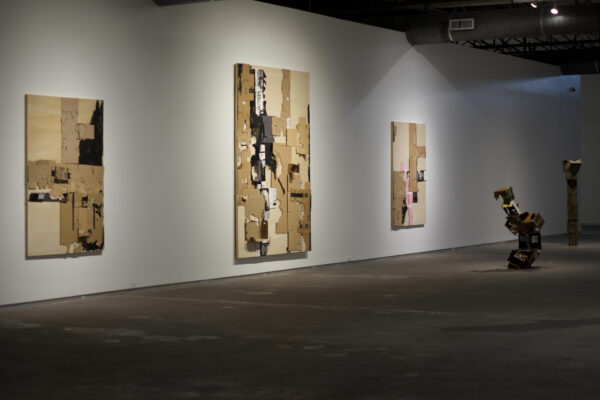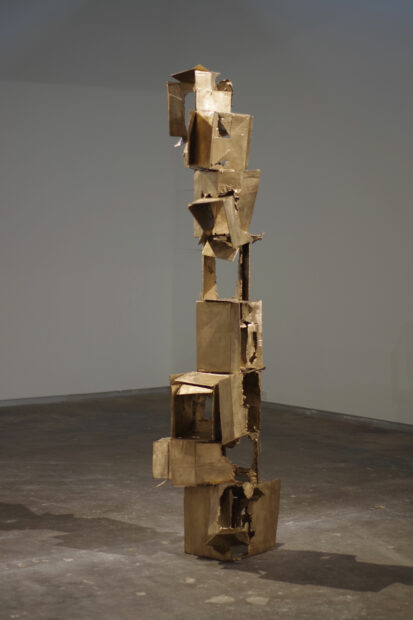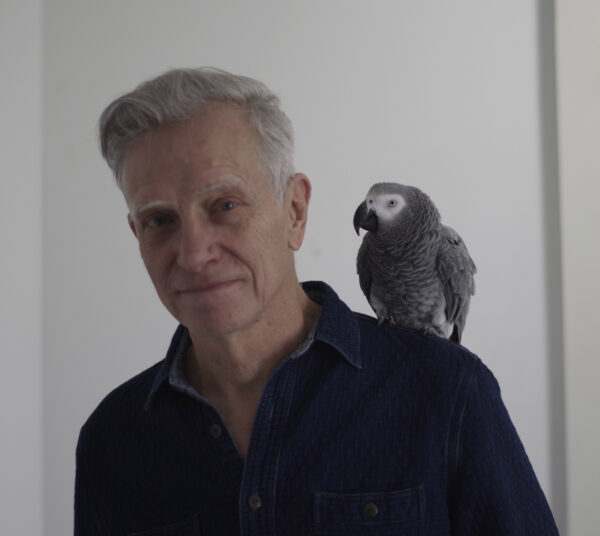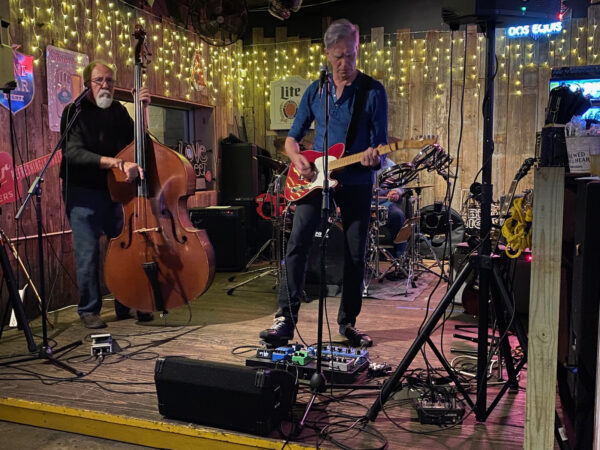Houston artist and educator Joseph Havel has been the director of the Museum of Fine Arts, Houston’s Glassell School of Art since 1991. After more than thirty years, he will be stepping down from his position at the end of June to focus solely on his personal artistic practice.
In a recent conversation, Havel reflected on his time at Glassell and discussed his current body of work executed in collaboration with Hannah, his parrot, along with his plans for the future.
Caleb Bell (CB): Your current body of work, which has been the focus of several recent exhibitions including Parrot Architecture at the Dallas Contemporary, is the result of a collaboration with Hannah, your African gray parrot. Before we discuss the work, can you tell me a little bit about Hannah and how long you have had her?
Joseph Havel (JH): Hannah is a female Congolese African gray. She is 24 years old. She was purchased as a baby just after being weaned to solid food and is domestically bred.
She has lived with me since.
CB: The first time I remember you two collaborating on a body of work was The Hannah Variations around 2017 or 2018. When was the first time you collaborated with her and how did it come about?
JH: We tentatively started in 2016 when I bought her some balsa wood to chew rather than a much more expensive parrot toy, which she loved to destroy. She shredded/carved two figures that looked like Giacometti figures; a small standing figure and a head of his brother, Diego. She seemed to mostly carve when I was in the room and she was looking for approval. This generated a good deal of research regarding her species and what had been discovered before, as well as her species habits and conditions in the wild. This led quickly into considerations of animal/non-human intelligence. It was a fascinating way to enter in a small way into her habits, instincts, and how I might fit into them. Over time, the questions about the environment, the Anthropocene, and the current moment of extinction of species based on human contact became important. And then the pandemic! It was evolving from a marginal consideration to something quite direct.

Works by Joseph Havel and his collaborator and pet parrott Hannah, on view at the Dallas Contemporary
CB: With the onset of the pandemic, how did the collaboration progress? What were some of your initial thoughts around its potential?
JH: The pandemic had a huge effect in a number of ways. The isolation that came with the quarantine meant that I was around Hannah much more each day. My partner and I live in an apartment above my studio and I had moved my office from a separate room into Hannah’s day room to make space for my partner’s studio, since we were all locked down together. Since Hannah mostly works on boxes or wood when I or Mary (my partner) are in the room, this accelerated the production.
Also, suddenly we were no longer going out to stores, but having everything from groceries to needed household items shipped. We had a plethora of boxes. Hannah mostly prefers working on boxes rather than wood; maybe in a 7/8 to 1/8 ratio. Boxes also are the easiest way to engage either of us as a participant, as she can play hide and seek as she cuts holes in them. We refined as well as expanded the box sizes she was comfortable with. Those are all practical developments.
It also focused me more on the related research, allowing me to read and expand my understanding of our engagement, from the species habits and brain structures all the way to questions about the Anthropocene and the extreme extinction moment we are currently in. It grounded everything intellectually and also as freed me to make more complex forms.
All of this led me to invest more and more artistic ambition into the potential and ask questions about how to keep both of our intentions intact, at least to the degree that I can understand them. Obviously my cultural motives are uniquely human, but how is what she is doing is uniquely part of African gray parrot culture? She recognizes that she worked on the sculptures, even if they have been turned into bronze. She also has a stopping point when she no longer feels the need to carve a box or piece of wood.
A friend who is involved in human brain science has told me that suggesting a parrot has the ability to be creative is hearsay, but that seemed such a human centric point of view. That seems to be broadly the same point of view that has been screwing up the planet to the point it’s going to be uninhabitable.

Sculptures by Joseph Havel and Hannah, his collaborator and pet parrot, on view at the Dallas Contemporary
CB: Once Hannah has finished her part, can you explain how you finish the works? What are you considering during that process?
JH: It’s not singular. There is not a process that is always the same, and this really reflects the naturalness of our process. Sometimes I assemble them, sometimes I assemble them and leave them in her “studio “ in case she wants to work on them more; sometimes I “curate” them and simply present them similar to what you see in Neighborhood, included in Parrot Architecture. Presentation, at whatever state, doesn’t matter to her, but is essentially human centric. Experience matters more to Hannah.
CB: I can only imagine how enlightening this whole collaborative process has been. Is there anything else that you would like to share about it? Maybe something that you’ve learned which surprised you?
JH: I have a fortune from a fortune cookie taped to my refrigerator that says “Always, always practice humility.” I think one thing I have learned and continue learning from this project is really to pay attention from a humble position. Author is the root word for authority, but what happens when you’re more of an orchestrator than a singular author? What lessons can be learned from listening and observing?
The exhibitions are up but I am back in my studio constructing and conjecturing. This morning Hannah carved on a new box while I had coffee. Quoting Harold Rosenberg, “Each artist must undertake to invent himself, a lifelong act of creation that constitutes the essential content of the artist’s work”; said simply, the job of an artist is to make an artist. Art works are the evidence, but for me, the process is important and takes humility. Working with Hannah continues to open me up to new wonders and takes me away from myself.

A sculpture by Joseph Havel and Hannah, his collaborator and pet parrot, on view at the Dallas Contemporary
CB: Your work has always dealt with materiality and that has continued with these pieces. In the past, you’ve also elevated mundane objects, as well as explored similar themes of deconstruction. Because of the way these newer works are created, there is a larger element of process present. How do you see this body of work in relation to past ones?
JH: I think in one way or another process has always been a part of my work. This perhaps is because my most influential teacher was the potter Warren MacKenzie, who integrated life/art in a way that no single object was elevated above the collective, and function was an inherent component. I was not a potter, but his philosophy greatly influenced me.
My relationship to performing craft as a way of both presenting and erasing self seems to be more of a focal point in this project. And of course, somehow, the activity of Hannah needs to be preserved instead of simply colonized in the final object. Maybe exposing process is an act of respect towards my collaborator.
CB: Speaking of influential teachers, you have been the director of the Glassell School of Art since 1991 and grown the program tremendously over the years. Towards the end of last year, you announced that you were going to step down from the position at the end of June. How did you reach that decision?
JH: A few years ago, I decided that when the Kinder building opened and the MFAH campus was complete, that it would be time to step away and focus full-time on my art practice, and frankly sleep a little more like a normal person. I have been a workaholic all my life and essentially have been working two full time jobs, getting up very early to do art work and not really taking weekends or vacation days pretty much since I was 20. I also did well with the creative side of being an artist, but was sloppy on the office side.
My job had changed too. When the school was moved to temporary spaces and we were building the new school, I was gradually moved more away from the Core Program and mentoring, which I feel was my signature program. I learned so much from the residents, and hope some also learned from me.
We moved into the new school building a little later than predicted, and then Covid hit. It would have been irresponsible to leave as the school worked through the pandemic, which was difficult. We also really hadn’t figured out the new building, which is fabulous but also has different challenges. I finally feel like we are on the endemic side of Covid and the table is set for the next director. We have great people running programs there right now. Mary Leclere is doing a great job with the Core. It seemed finally, for both my good and the next phase for the school, it was time to step away.
CB: I know you can’t touch on everything, but what are some of the things you are most proud of accomplishing while at the school?
JH: I am very proud of the work I have done with the Core Program. I am pleased to have remained flexible, always asking questions in all programs, particularly the Core and Studio School, from the point of view of an artist. I never really felt like an administrator; I was simply an artist trying to make a better community in which to make and love art. I made mistakes, but listened well and learnd.
Perhaps the new Glassell building and the more direct linkage of the school to the rest of the museum is icing on the cake. I also appreciated the work I did assisting the development of the art residency at Maison Dora Maar in the south of France. It used to be under the guidance of the MFAH, but has recently become an independent program. Finally, I have had a wonderful time helping Mari Carmen Ramirez buy art from artists from the Caribbean. She has become a dear friend. Really, over thirty years, I have been blessed to shepherd change and empower colleagues with good ideas to manifest them. It’s been a good run! Now it’s time to primarily spend my time on my own art practice.
CB: Come July, with the new found studio time, do you have any projects or ideas that you are eager to explore?
JH: I will be in France much of July, August and September. I have an exhibition opening there in a fairly unique nonprofit exhibition space in about a year. I have some ideas, but want to do a site visit and clarify them. I’m also continuing the evolving Hannah work in the studio now and in France, as she is traveling with me. I don’t see a radical shift in my practice at the moment, but rather an evolution of work related to ideas in the Dallas Contemporary exhibit; however, I’m trying to simply be open and respond. I’m sure another solo exhibition will also surface in the next year in the U.S. Having more time is a new frontier!
CB: What do you think more time will mean for your band, Lindale? More gigs?
JH: Ha!! I’m sure when I’m back from France Lindale will rise again! I told them I will write some new songs and send them the rough recordings while I’m away. Look for a new playlist at our post summer shows!
CB: I will be sure to be on the lookout. Joe, congratulations on the recent exhibitions, your approaching retirement from Glassell, and all of the new adventures.
This interview has been edited for length and clarity.






2 comments
My 20 yr-old niece and I are sitting on the porch watching the sunset in Pittsburgh, Pennsylvania while reading this interview. She told me that she has been looking for artists and art work that restores her faith in humanity and we both agreed that this collaboration between Joseph and Hannah is so special. It makes our hearts glad. We are listening to the birds sing while we contemplate what new projects Joseph and Hannah may have on the horizon.
I loved sharing Joseph’s work with my university students this spring at the Dallas Contemporary. A breath of fresh air in what sometimes feels like a very cynical art world.
Wonderful reporting and revealing interview.